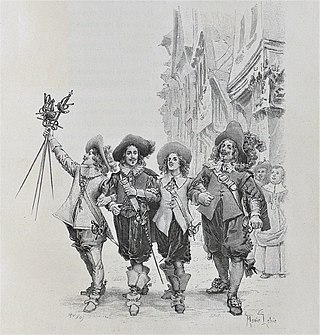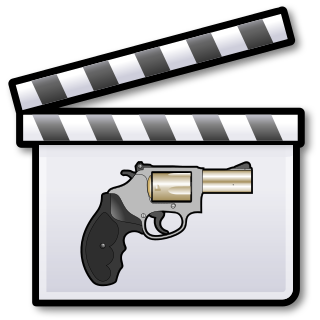
Martial arts films are a subgenre of action films that feature martial arts combat between characters. These combats are usually the films' primary appeal and entertainment value, and often are a method of storytelling and character expression and development. Martial arts are frequently featured in training scenes and other sequences in addition to fights. Martial arts films commonly include hand-to-hand combat along with other types of action, such as stuntwork, chases, and gunfights. Sub-genres of martial arts films include kung fu films, wuxia, karate films, and martial arts action comedy films, while related genres include gun fu, jidaigeki and samurai films.
Spy fiction is a genre of literature involving espionage as an important context or plot device. It emerged in the early twentieth century, inspired by rivalries and intrigues between the major powers, and the establishment of modern intelligence agencies. It was given new impetus by the development of fascism and communism in the lead-up to World War II, continued to develop during the Cold War, and received a fresh impetus from the emergence of rogue states, international criminal organizations, global terrorist networks, maritime piracy and technological sabotage and espionage as potent threats to Western societies. As a genre, spy fiction is thematically related to the novel of adventure, the thriller and the politico-military thriller.

Wuxia is a genre of Chinese fiction concerning the adventures of martial artists in ancient China. Although wuxia is traditionally a form of historical fantasy literature, its popularity has caused it to be adapted for such diverse art forms as Chinese opera, manhua, television dramas, films, and video games. It forms part of popular culture in many Chinese-speaking communities around the world. According to Hong Kong film director, producer, and movie writer Ronny Yu, wuxia movies are not to be confused with martial arts movies.

The spy film, also known as the spy thriller, is a genre of film that deals with the subject of fictional espionage, either in a realistic way or as a basis for fantasy. Many novels in the spy fiction genre have been adapted as films, including works by John Buchan, le Carré, Ian Fleming (Bond) and Len Deighton. It is a significant aspect of British cinema, with leading British directors such as Alfred Hitchcock and Carol Reed making notable contributions and many films set in the British Secret Service.

The action film is a film genre that predominantly features chase sequences, fights, shootouts, explosions, and stunt work. The specifics of what constitutes an action film has been in scholarly debate since the 1980s. While some scholars such as David Bordwell suggested they were films that favor spectacle to storytelling, others such as Goeff King stated they allow the scenes of spectacle to be attuned to story telling. Action films are often hybrid with other genres, mixing into various forms ranging to comedies, science fiction films, and horror films.

Sword and sorcery (S&S) or heroic fantasy is a subgenre of fantasy characterized by sword-wielding heroes engaged in exciting and violent adventures. Elements of romance, magic, and the supernatural are also often present. Unlike works of high fantasy, the tales, though dramatic, focus on personal battles rather than world-endangering matters. Sword and sorcery commonly overlaps with heroic fantasy. The genre originated from the early-1930s works of Robert E. Howard. The term "sword and sorcery" was coined by Fritz Leiber in the May 1961 issue of the fantasy fanzine Amra, to describe Howard and the stories that were influenced by his works. In parallel with "sword and sorcery", the term "heroic fantasy" is used, although it is a more loosely defined genre.
A techno-thriller or technothriller is a hybrid genre drawing from science fiction, thrillers, spy fiction, action, and war novels. They include a disproportionate amount of technical details on their subject matter ; only hard science fiction tends towards a comparable level of supporting detail on the technical side. The inner workings of technology and the mechanics of various disciplines are thoroughly explored, and the plot often turns on the particulars of that exploration. This genre began to exist and establish itself in the early 20th century with further developments and focus on the genre in the mid 20th century.

Mystery is a fiction genre where the nature of an event, usually a murder or other crime, remains mysterious until the end of the story. Often within a closed circle of suspects, each suspect is usually provided with a credible motive and a reasonable opportunity for committing the crime. The central character is often a detective, who eventually solves the mystery by logical deduction from facts presented to the reader. Some mystery books are non-fiction. Mystery fiction can be detective stories in which the emphasis is on the puzzle or suspense element and its logical solution such as a whodunit. Mystery fiction can be contrasted with hardboiled detective stories, which focus on action and gritty realism.

Genre fiction, also known as formula fiction or popular fiction, is a term used in the book-trade for fictional works written with the intent of fitting into a specific literary genre in order to appeal to readers and fans already familiar with that genre.

Thriller is a genre of fiction with numerous, often overlapping, subgenres, including crime, horror, and detective fiction. Thrillers are characterized and defined by the moods they elicit, giving their audiences heightened feelings of suspense, excitement, surprise, anticipation and anxiety. This genre is well suited to film and television.

A swashbuckler is a genre of European adventure literature that focuses on a heroic protagonist stock character who is skilled in swordsmanship, acrobatics, and guile, and possesses chivalrous ideals. A "swashbuckler" protagonist is heroic, daring, and idealistic: he rescues damsels in distress, protects the downtrodden, and uses duels to defend his honor or that of a lady or to avenge a comrade.

Crime films, in the broadest sense, is a film genre inspired by and analogous to the crime fiction literary genre. Films of this genre generally involve various aspects of crime and its detection. Stylistically, the genre may overlap and combine with many other genres, such as drama or gangster film, but also include comedy, and, in turn, is divided into many sub-genres, such as mystery, suspense or noir.

An action hero is the protagonist of an action film or other form of entertainment which portrays action, adventure, and often violence. Action heroes are depicted in exciting or perilous chase sequences, fights, shootouts, explosions, and stunt work. Other media in which such heroes appear include swashbuckler films, Western films, old-time radio, adventure novels, dime novels, pulp magazines, and folklore.

Adventure fiction is a type of fiction that usually presents danger, or gives the reader a sense of excitement. Some adventure fiction also satisfies the literary definition of romance fiction.
Popular Publications was one of the largest publishers of pulp magazines during its existence, at one point publishing 42 different titles per month. Company titles included detective, adventure, romance, and Western fiction. They were also known for the several 'weird menace' titles. They also published several pulp hero or character pulps.

Thriller film, also known as suspense film or suspense thriller, is a broad film genre that evokes excitement and suspense in the audience. The suspense element found in most films' plots is particularly exploited by the filmmaker in this genre. Tension is created by delaying what the audience sees as inevitable, and is built through situations that are menacing or where escape seems impossible.
A romantic thriller is a narrative that involves elements of the romance and thriller genres. A good thriller provides entertainment by making viewers uncomfortable with moments of suspense, or the heightened feeling of anxiety and fright. A thriller is more a familiar concept and description than a pure genre. A typical genre can vary from comedy and melodrama to adventure and romance. All thrillers are a combination of different genres. The basic thriller trait of suspense fits with some genres better than others. For example, crime, sci-fi and romance allow more scope for suspense than screwball comedies or musicals do.
In literature, pace or pacing is the speed at which a story is told—not necessarily the speed at which the story takes place. It is an essential element of storytelling that plays a significant role in maintaining reader interest, building tension, and conveying the desired emotional impact. The number of words needed to write about a certain event does not depend upon how much time the event takes to happen; it depends upon how important that moment is to the story. The pace is determined by the length of the scenes, how fast the action moves, and how quickly the reader is provided with information. A well-paced story effectively balances moments of high intensity and slower-paced sections to create a dynamic reading experience. It is also sometimes dictated by the genre of the story: comedies move faster than dramas; action adventures move faster than suspense. A dragging pace is characteristic of many novels turned down by publishers, and of some that find their way into print but not into the hearts and recommendations of readers. Manuscripts that move too slowly usually discourage readers from reading on. Through various editing techniques, such as cutting unnecessary details, rearranging scenes, or suggesting additions, editors assist in maintaining an engaging pace that keeps readers captivated. Yanna Popova and Elena Cuffari elaborate that as editors they, "explore the participatory structure of a narrative through its temporal unfolding and the specific, non-linear nature of the temporal dynamics of interacting with a storytelling agency". Popova and Cuffari make clear that the way an author unfolds a story through structuring that narrative's tale is essential to the way the audience will interpret it.











